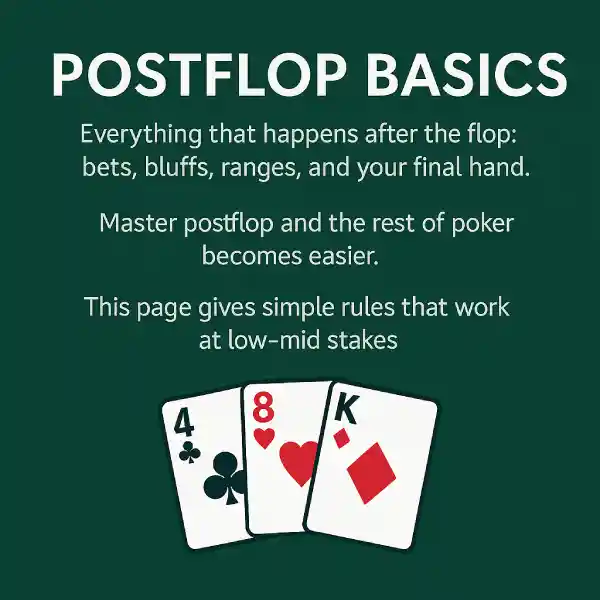Check
Do nothing; pass action. Good for hands that want to see a card or to protect your checking range.
“Postflop” is everything after the deal: the flop (3 cards), turn (1 card), and river (1 card). Your job is to bet for value when ahead, bluff when it’s smart, and fold when behind. Keep it simple, play in position, and use clear bet sizes.
Most info appears here. Small c-bets work on many dry boards.
Bigger bets on wet boards. Value grows; many draws appear or miss.
Final decision. Value bet thinly vs callers; bluff when story makes sense.

3 community cards. Decide: small c-bet or check. Ask: who has the advantage on this board?
4th card. Pot grows fast. Use bigger bets on wet boards; many hands become clear value or clear folds.
5th card. Final bet/raise/call/fold. Value bet when worse can call; bluff when better hands can fold.
Do nothing; pass action. Good for hands that want to see a card or to protect your checking range.
Value (worse hands call) or bluff (better hands fold). Choose a size with a purpose.
Continue with enough equity or with showdown value. Prefer calling in position.
Build pot with strong value or apply pressure with strong draws. Use bigger sizes vs draw-heavy boards.
Want exact sizes? See Bet Sizes (Easy Guide).
An out is a card that improves your hand to likely winner. Example: Four to a flush = 9 outs.
Turn to river only → multiply outs by 2. From flop to river → multiply by 4.
Break-even equity = bet / (pot + bet). If your chance to win is higher, call is OK.
More examples: Odds & Outs.
Dry boards, range advantage, frequent c-bets.
Default size on many turns and rivers.
Wet boards; charge draws; strong value / strong draws.
When you have nut advantage on turn/river. Polarised range.
Deep dive here: Bet Sizes.
Flop K-7-2r with KQ. Line: Bet small flop → Bet turn on bricks → River value vs worse kings/7x if called before.
Flop J♥-9♥-3♦ with A♥5♥. Line: Bet bigger (charge) → Barrel some turns → River bluff spades/straight cards if you miss.
Information only. We do not run games or accept bets. In Uganda, casinos and most betting are 25+.
We use cookies to make the site work and to understand which guides help readers. You can accept, reject, or customize. See our Privacy Policy and Terms.
Choose which categories you allow. Essential cookies are always on because the site won’t work without them.